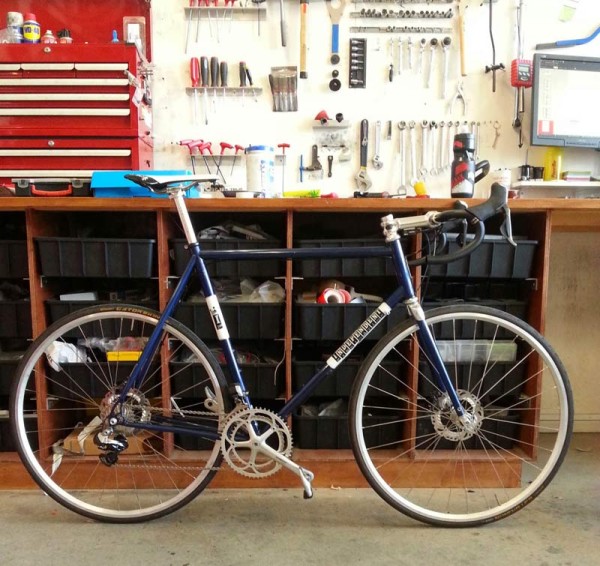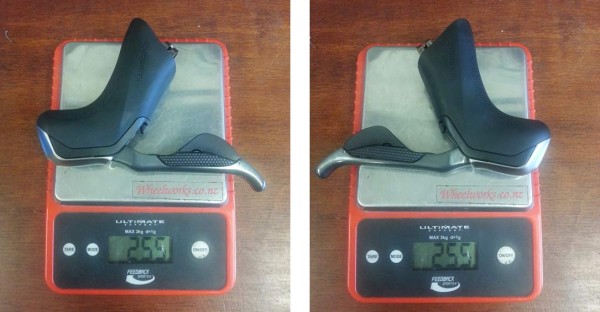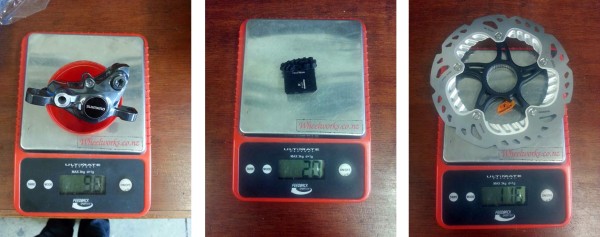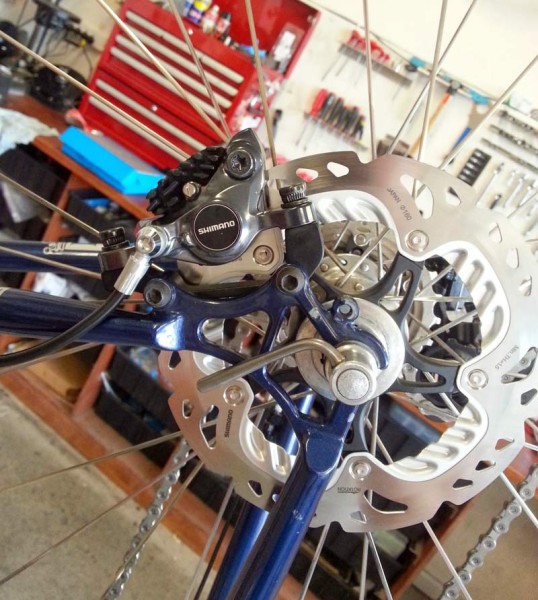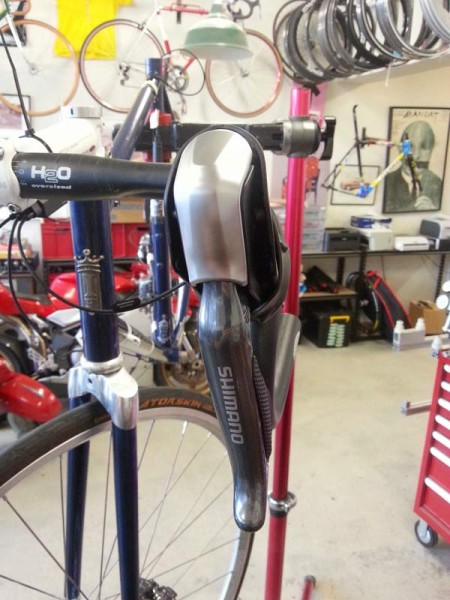Thanks to our friends over at Wheelworks in New Zealand, (who’ve sent us some interesting articles before) we’ve got some actual weights on the new Shimano SH-R785 road bike hydraulic disc brakes.
Mounted up to this gorgeous Independent Fabrication road bike, they’re currently using a Campy crank until their longer 177.5 Dura Ace cranks arrive, and use larger 160mm rotors since 140mm Freeza rotors aren’t available for the rear. Personally, I’d stick with 160mm rotors front and rear, but that’s just me. Click through for their weigh in photos, install notes and first impressions…
Levers both come in at 255g each.
Calipers are 98g, finned IceTech brake pads are 20g and a 160mm Centerlock rotor is 116g.
GUEST REVIEW – First impressions from Tristan at Wheelworks NZ
I was super lucky to get an early production version of the new R785 hydraulic road disc brake system and fit it onto my Independent Fabrication. I’m writing a full review for NZ Road Cyclist magazine but I know there is quite a bit of interest around this kit so I wanted to write a short overview.
In the box
The boxed R785 ‘kit’ includes the following:
- Two Di2 STI shifters
- Two brake calipers
- Two sets of finned brake pads
- Two hoses (different lengths; one front and one rear) with all the required olives and barbs. There are no spare olives or barbs.
- Two bottles of Shimano mineral oil brake fluid
- EL-EW02 tool to remove and install Di2 wires
There are no adapters or rotors in the kit – you’ll need to organize these separately. I really like how Shimano no longer includes adapters as there are now many different ‘standards’ so it makes a lot of sense to leave them out of the box.
I used the new Freeza rotors in 160mm front and rear. I’d like a 140mm rear but it’s not available until March. Freeza rotors are only available in the splined Center Lock interface.
The Freeza rotors use a similar construction to the ICE rotors where aluminum is sandwiched between two steel sections. The steel deals well with the friction of braking without wearing out and the aluminum draws the heat away. The Freeza section of the rotor incorporates aluminum fins which expand the rotor’s surface area increasing cooling.
The supplied finned pads use an aluminum backing to draw heat away from the pad and into the finned area.
The calipers use ceramic pistons to insulate the caliper and brake fluid from heat.
The R785 Di2 levers will work with any Shimano e-tube Di2 components: Ultegra 10 speed 6770 or 11 speed 6870 or DuraAce 11 speed 9070. I chose 9070 because the polished silver highlights match the bike.
Install
Over the past year Shimano has created the awesome si.shimano website and has removed most of the printed manuals from the component boxes. The info on the si site is really good and well worth the read when it’s your first time installing a new component. Using the dealer manual (“DM” on the website) the installation was very straight forward, however I do have a lot of experience with Shimano’s hydraulic mountain bike brakes.
The only non-standard tool required is the yellow cup for bleeding the brakes (which is not included in the kit) however this tool has been required on mountain bike brakes over the past few years so should be commonplace by now.
A hydraulic hose cutter makes things a lot easier and neater – I use an old Avid tool but there are plenty of options on the market now.
The most difficult thing about the install was getting the hoods back in place! Each hood can be peeled back from both the front and the rear, and the front uses 6 small plugs to hold onto the lever body…I found these plugs a nightmare to seat correctly but ended up using an awl to gently push each one into the lever body.
The shape of the levers is very similar to the other Shimano Di2 levers and is narrower through the body than the equivalent mechanical version. The R785 lever extends upwards more at the ‘point’ but not nearly as much as the SRAM hydraulic lever, and in real-life the lever looks far less bulbous than it does in photos.
The brake lever blades have a pronounced hook at the bottom and are very comfortable when braking from either the hoods or the drops.
The Di2 side of the install is as easy or difficult as you make it – if you have previous experience with Di2 you’ll know how straight-forward the basics are but how difficult it can be to hide the wires and make a nice, clean install.
Unlike other Di2 shifters there is only one e-tube port on each shifter. Sprint or climbing shifters cannot plug into the STI.
Once installed I updated the firmware with the SM-PCE1 box. It frustrates me that this box cannot also charge the system – seems like a wasted opportunity.
I’d initially ordered a pair of the new XTR M987 magnesium calipers to save some weight and because I hoped they looked like the polished M985 calipers, however they’re a matte silver which didn’t look good on the bike, and the weight saving of 20g per caliper didn’t justify the price (to me). It’s also worth mentioning that the calipers that come with the R785 levers aren’t black – they’re closer to the same (very nice) dark gray color scheme as the CX-77 brakes, though this doesn’t come through well in photos where they often appear completely black.
Braking
It’s honestly hard to explain how good the braking is to a typical roadie. The whole “I can lock my brakes up on my rim-brakes” argument is just total crap – disc brakes are still limited by the tire’s traction and won’t give you more power but what they will give you is an amazing amount of control over that power. Bringing the brake right to the limit of tire-traction is easy and smooth, with almost zero effort required.
In the dry the brakes are better than, say, DuraAce 9000 rim brakes. In the wet it’s just another level: there is no appreciable loss of power from the brake. In the wet the extra control and modulation really shine. To give an example: I took it really easy down a steep, twisty, wet descent but at the bottom had opened up a huge gap on the guys I normally ride with who said they had been on the limit pushing to try and keep up.
These brakes squeal and honk less than other discs I’ve used or seen but do let out the occasional noise. In early testing, very occasionally I’ll get a slight noise before the rotor warms up – generally this has been in the rain.
If you’ve ridden Shimano’s hydraulic mountain bike brakes then these R785s won’t be much of a surprise as they feel very similar. That’s a huge compliment.
There is absolutely no doubt in my mind that these disc brakes outperform the best rim brakes by a considerable margin.
Shifting
Enough has been written about Di2 shifting that I don’t really need to echo: simply put it’s amazing, especially the front derailleur. While waiting for the 177.5mm DuraAce cranks to arrive I’ve been using a pair of square-taper Campagnolo Record 39/53 cranks and the shifting is amazing with the DuraAce chain.
I do find I get occasional false-positives with the non-textured shift paddle. I hit the paddle, it feels like it’s engaged the button, but no shift. This reminds me of the first generation 7090 DuraAce shifters and I find it strange because the 9070 and 6870 shifters don’t seem to have these mis-shifts.
Downsides
Weight: All-up these are about 350 grams heavier than an Ultegra Di2 lever and rim brake, and 110 grams heavier than an Ultegra Di2 lever and cable-operated disc brake.
In comparison to rim brakes the frame and hubs will also be heavier to accommodate the disc brakes, however some of this weight might be able to be reclaimed by using lighter disc-specific rims.
Aero: The calipers positioned in reasonably clean air plus the Freeza rotors creating a wash of turbulence to cool the calipers probably don’t translate into a super-aero setup. I’m sure there will be some empirical testing done on this as disc brakes enter the mainstream but for now it’s just a guess that a traditional rim brake would be more aero.
No doubt over time disc brakes will get lighter and if they’re starting to be used on racing bikes they’ll get more aero. For the time being these downsides mean the brakes are best suited for people who ride in the rain and don’t view an uber light bike as the most important measure.
Conclusion
After using the road version of Avid’s BB-7s for many years and setting up quite a few bikes with Shimano’s mechanical CX-75 and CX-77 brakes I really can’t recommend the R785 hydraulic enough. If you’ve committed to a disc brake road bike the only reason to choose one of these other options is a slight weight decrease, however in terms of lever feel and power the R785 is a long way ahead. For those who ride hilly terrain in the wet this brake is the current gold-standard.
I’m more than happy to answer questions but please do me a favor and ride this brake or another high-end disc brake before making “there is no need for discs as my rim brakes work well-enough” comments.
Huge thanks to Tristan for sending this in!
